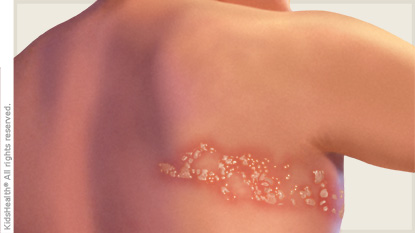Shingles
Article Translations: (Spanish)
What Is Shingles?
Shingles, also called zoster or herpes zoster, is a skin rash caused by a viral infection of the nerves right below the skin.
What Causes Shingles?
The varicella zoster virus causes shingles and chickenpox. Anyone who has had chickenpox can later develop shingles — even children. That's because the virus stays dormant (resting) in the nervous system for the rest of a person's life.
In many people, the virus never comes back. But in others, it flares up and causes shingles. It's uncommon for someone to get shingles more than once.
People of all ages can get shingles, but most cases are in people over 50 years old.
What Are the Signs & Symptoms of Shingles?
Often the first shingles symptoms happen in the area where the rash will appear. A person may have tingling, itching, or pain in this area. When the rash shows up, the pain may be mild or severe.
The rash starts as groups of tiny pimples on one side of the body or the face. It's often in the shape of a band or belt. The pimples change to pus-filled blisters that break open and scab over in about 7–10 days. The scabs usually heal and fall off about 2–4 weeks after the rash starts.

Some kids with shingles also may have a fever and a headache, and might feel tired and achy. Rarely, a child has the pain of shingles without the rash. More severe symptoms can happen, but usually in people over age 50.
What Problems Can Happen?
Most cases of shingles heal on their own, with or without treatment, and won't lead to any other problems. In rare cases, shingles can lead to complications, including:
- Ongoing pain (post-herpetic neuralgia): Damaged nerve fibers in the skin send confused messages to the brain, leading to pain. Pain can go on for a long time after the shingles rash is gone. This is the most common shingles complication.
- Vision problems: Shingles near or in an eye can lead to vision loss.
- Skin infections: A shingles rash can become infected with bacteria, leading to impetigo or cellulitis.
- Nervous system problems: Shingles on the face can involve different nerves that connect to the brain. This can lead to nerve-related problems such as facial paralysis, hearing problems, and problems with balance. In very rare cases, shingles can lead to encephalitis (inflammation of the brain).
How Is Shingles Diagnosed?
Doctor usually can diagnose shingles by looking at the rash. Rarely, a doctor may send a small sample of infected skin to be checked in a laboratory.
If you think your child might have shingles, call your doctor. If your child might have shingles on the face, it's important to get a doctor's help right away to keep the infection from spreading to the eyes.
How Is Shingles Treated?
Not all kids who get shingles need treatment. If a doctor decides a treatment may help, it should start right away. Treatment usually includes an antiviral medicine and pain-control medicines.
Antiviral medicines like acyclovir (Zovirax) or valcylovir (Valtrex):
- help heal the skin rash
- stop the virus from multiplying
- help control pain
Pain medicines (over-the-counter or prescription creams, sprays, or skin patches):
- help control pain
- ease inflammation (swelling and redness)
Medicines can't rid the body of the virus, but they can lower the chances of complications and help speed healing. Ask your doctor if treatment might help your child.
As the rash heals, keep the area clean. Wash it with water and a mild soap, and apply cool, wet compresses to the blisters several times a day to ease pain and itching. Oatmeal baths also can bring relief.
To prevent the virus from spreading to other people, keep the rash covered at all times.
Can Shingles Be Prevented?
It's not always possible to prevent shingles. But the chickenpox vaccine can make a case of shingles less serious. If your child hasn't had chickenpox, ask your doctor about getting the chickenpox vaccine.
There is a shingles vaccine, but it's mostly given to older adults. The older someone is, the more severe shingles can be. Kids are unlikely to be seriously affected by shingles.
What Else Should I Know?
Children whose shingles rash that can't be completely covered should not go to school or childcare until the blisters scab over and are dry.
Newborn babies, pregnant women, people with weakened immune systems, and anyone who is not immune to chickenpox should avoid close contact with anyone who has shingles until the rash is gone.
Note: All information is for educational purposes only. For specific medical advice, diagnoses, and treatment, consult your doctor.
© 1995-2024 KidsHealth ® All rights reserved. Images provided by iStock, Getty Images, Corbis, Veer, Science Photo Library, Science Source Images, Shutterstock, and Clipart.com

